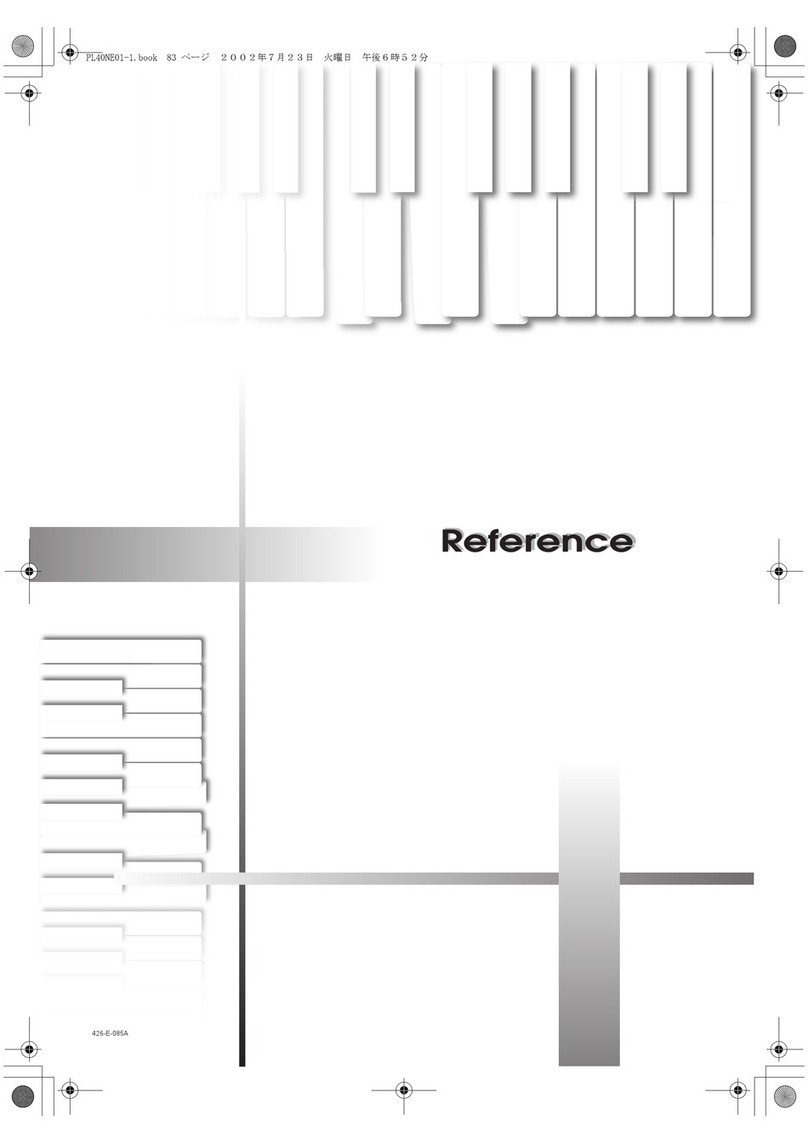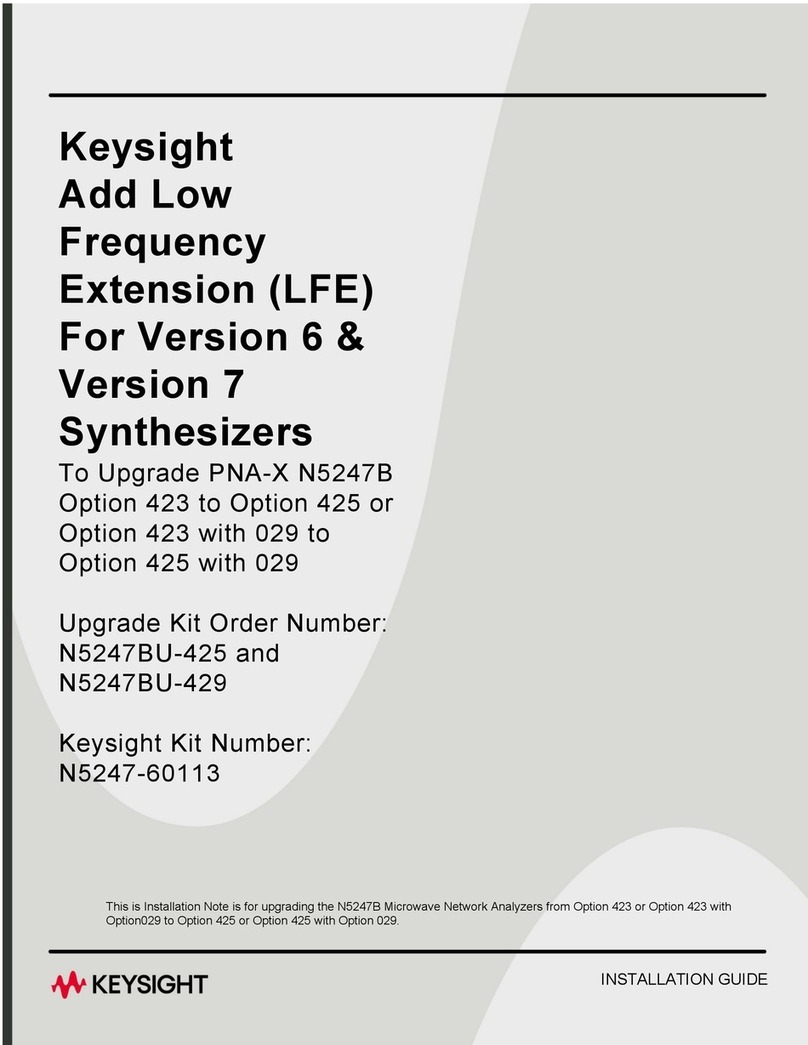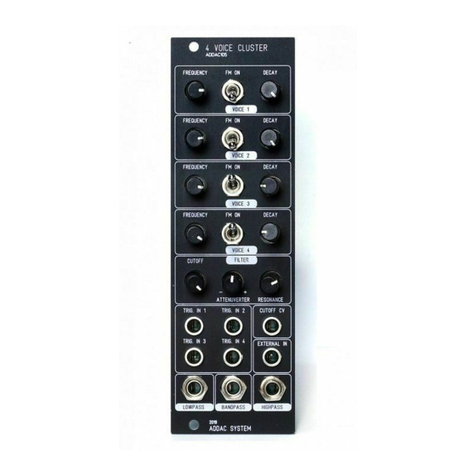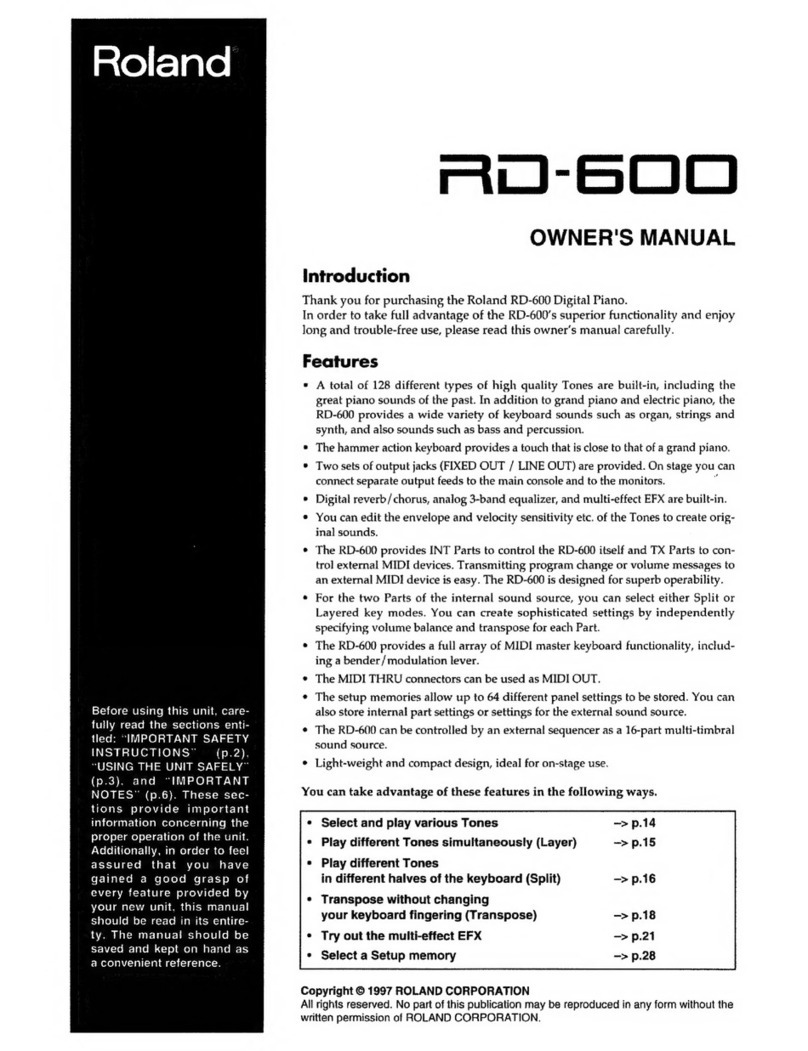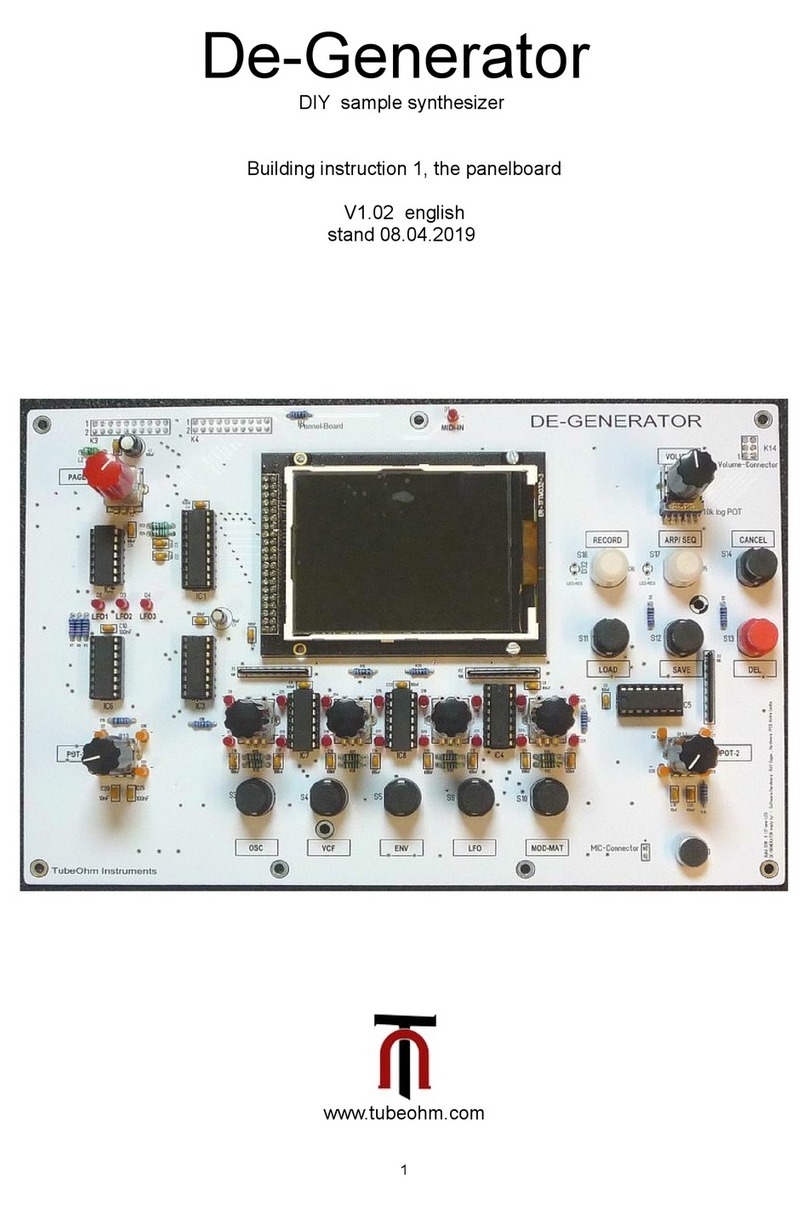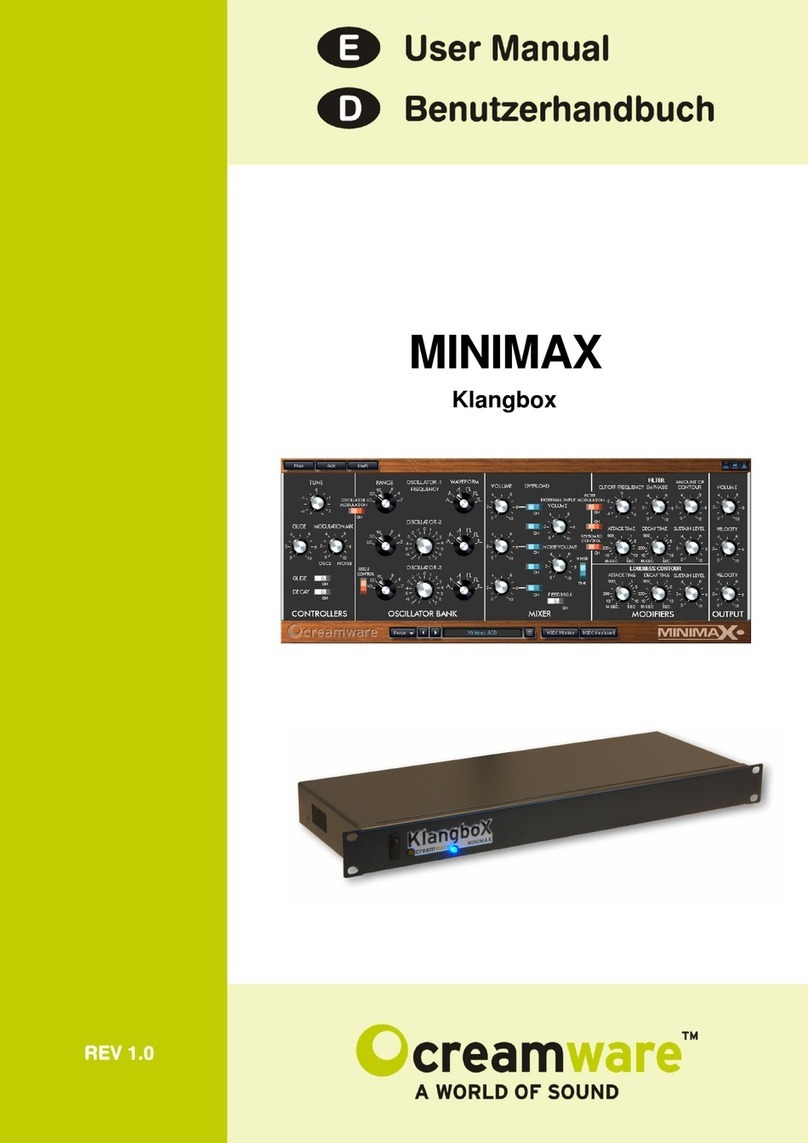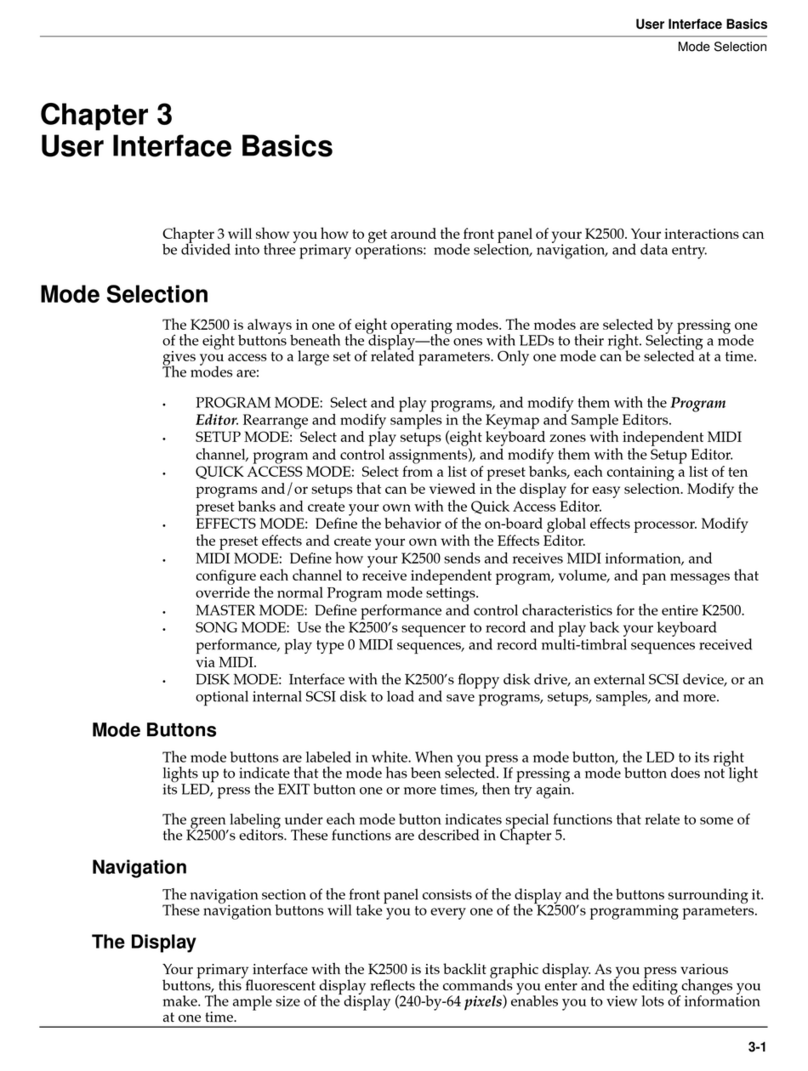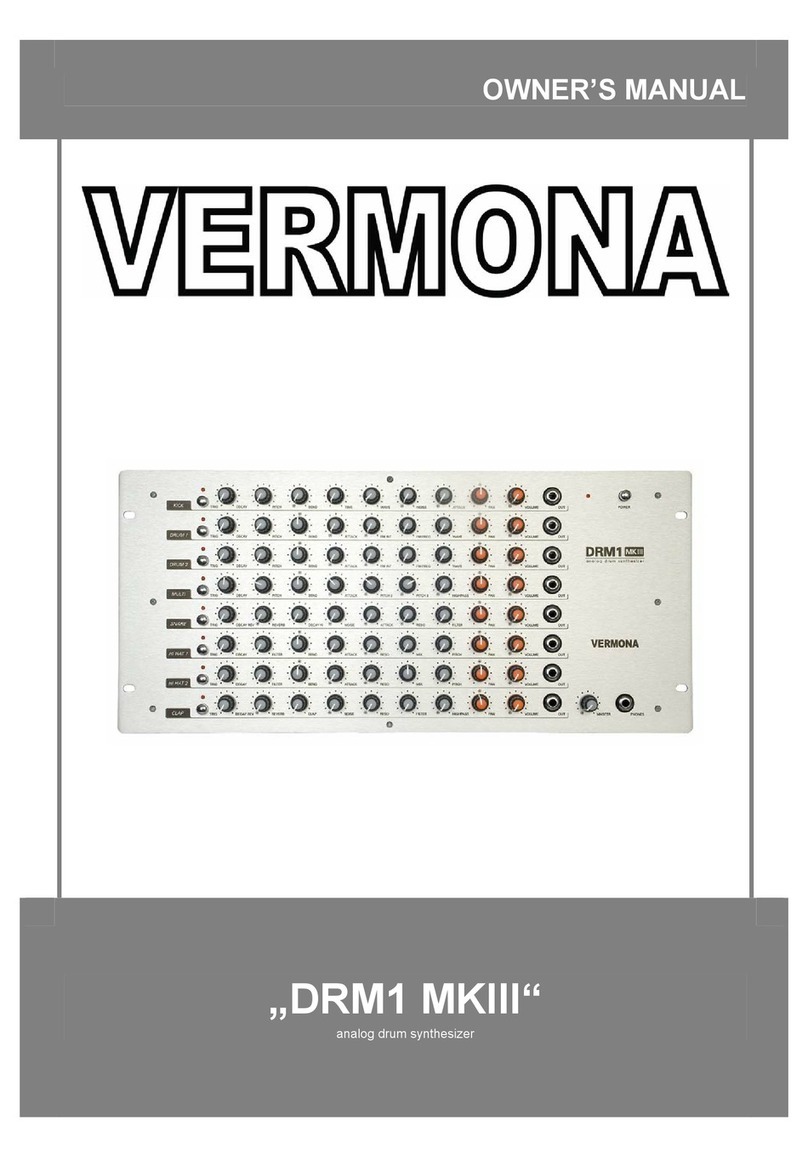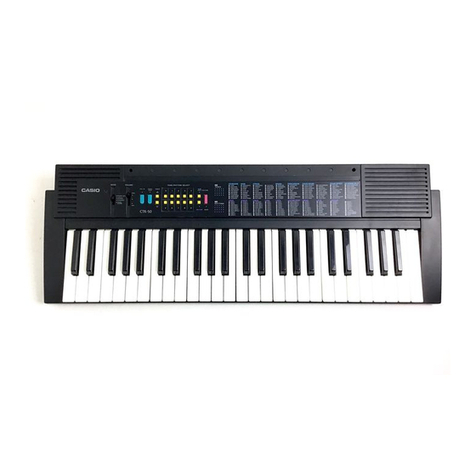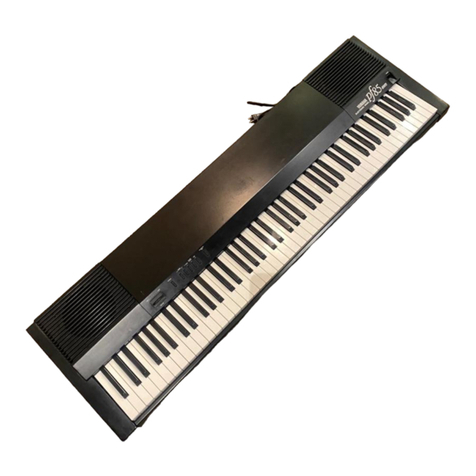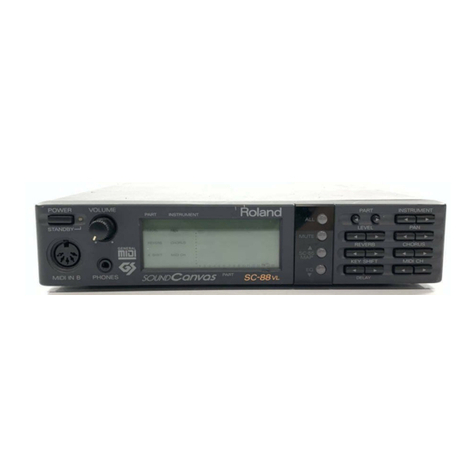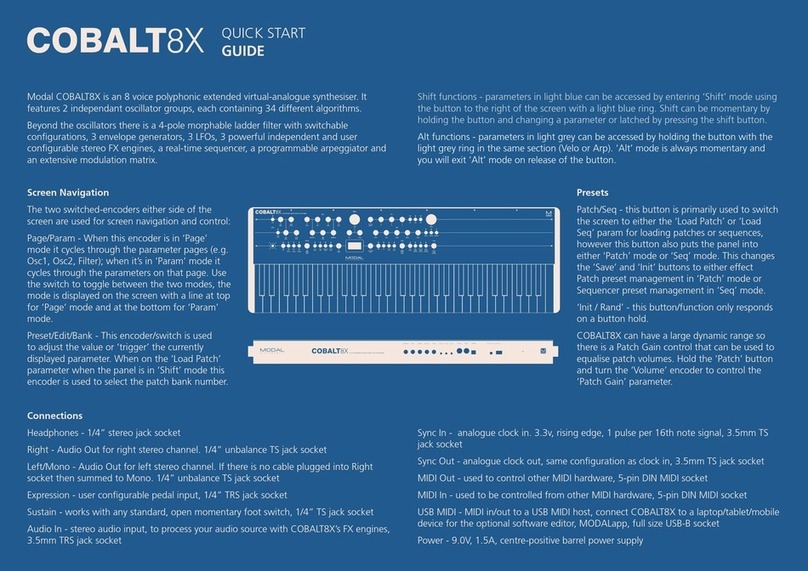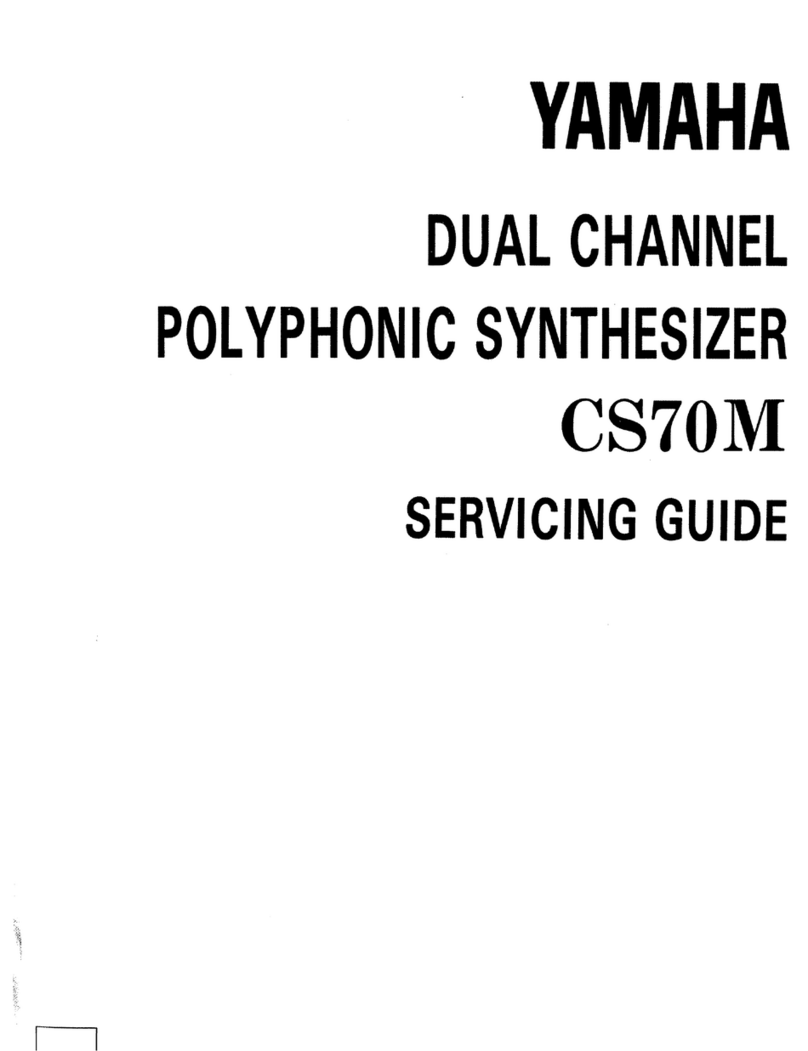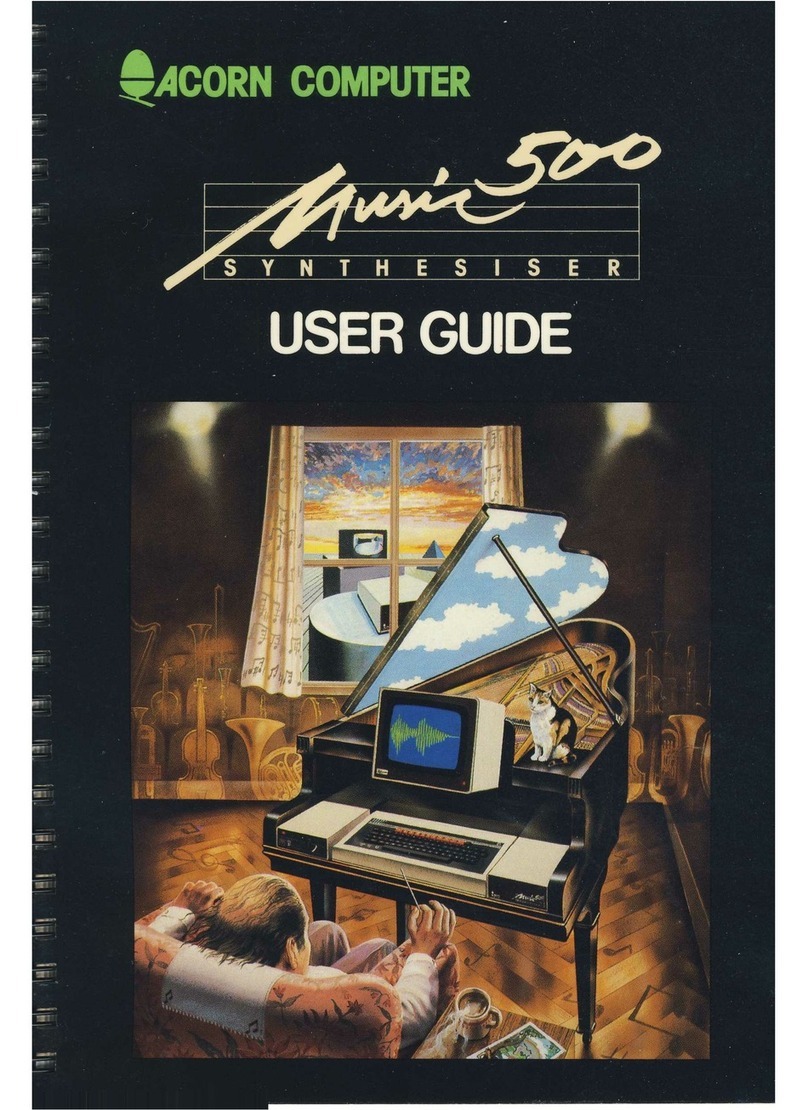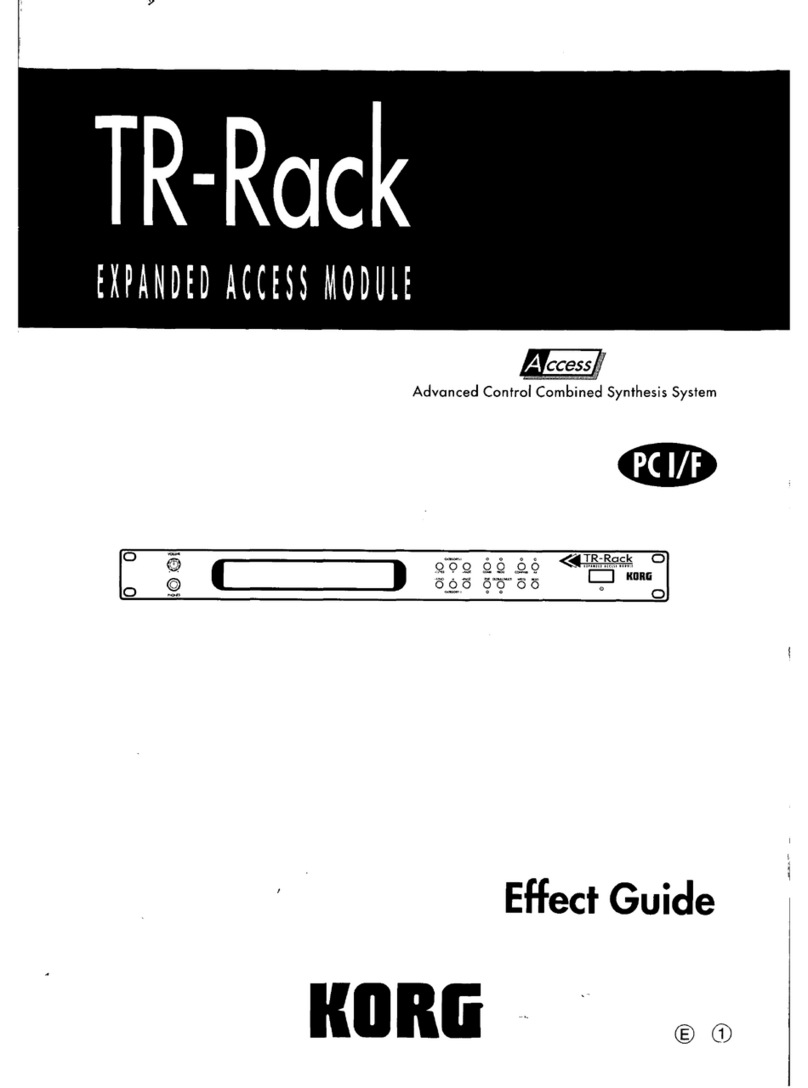Elby Designs EURO-SERGE User manual


EURO-SERGE - INTRODUCTION
ELBY Designs - Laurie Biddulph
9 Follan Close, Kariong, NSW 2250, Australia
[email protected] http://www.elby-designs.com
1 of 21
ACKNOWLEDGEMENTS
My gratitude goes out to the following for their advice and assistance in
completing this book:-
(in alphabetical order...)
Todd Barton
Kevin Fortune
Darrel Johansen
Doug Lynner
Ken Stone
Paul Young
Released 2018
Year of the Euro-Serge Dog
Euro-Serge released October 2014

EURO-SERGE - INTRODUCTION
ELBY Designs - Laurie Biddulph
9 Follan Close, Kariong, NSW 2250, Australia
[email protected] http://www.elby-designs.com
2 of 21
ABOUT THIS MANUAL
This manual is an instruction and users manual for the Euro-Serge Modular
Synthesizer. It is intended to serve two purposes:
1. A self-tutorial instruction manual for those who have never used a
synthesizer before and for those who have used a synthesizer, but not a
Euro-Serge, before.
2. A User's Reference Manual and Guide that provides information on how to
use each module, how to interconnect modules to produce certain effects and
how to interconnect the Euro-Serge with other devices.
This manual is arranged into the following sections:
The Introduction (Book 1)
Self-Teaching Patches #1 (Book 2)
The Theory of Electronic Music (Book 3)
Self-Teaching Patches #2 (Book 4)
System Modules (Book 5)
So What Does It Sound Like? (Book 6)
Euro-Serge Catalogue (Book 7)
Appendices (Book 8)
If you have never used a synthesizer before it is strongly suggested that you
read ‘The Introduction’ and ‘Self-Teaching Patches #1’ sections, working out
the patches as you go. If you are confused at this point, don't worry, keep
going. These exercises will give you the basis for understanding the
explanations in subsequent chapters.
If you have used a synthesizer, but not a Euro-Serge, the patches worked
through in ‘Self-Teaching Patches #2’ provide a good working knowledge of
the basic modules of the Euro-Serge. If you are already familiar with the
Serge/Euro-Serge system, specific information on the different modules and

EURO-SERGE - INTRODUCTION
ELBY Designs - Laurie Biddulph
9 Follan Close, Kariong, NSW 2250, Australia
[email protected] http://www.elby-designs.com
3 of 21
how to patch them together can be found in the sections ‘Self-Teaching
Patches #2 and ‘System Modules.
For information on interfacing to other equipment, refer to the Appendices.
This manual comprises eight chapters which exist as eight separate PDF files.
These files are all placed on, and should, ideally, be accessed from, the
internet for easy access to ensure that you have the latest copy.
This manual makes extensive use of hyperlinks for animated graphics,
module specific datasheets and links to other chapters, all of which will
require internet access.
All chapters are easily accessed from page 2 of this chapter. At the end of
each chapter is a link to the next chapter so you need only need to
remember/store a link to The Introduction.
This manual refers to the 4mm version of the Euro-Serge modules
as this affords the user the best Serge experience. 4mm
connectors are also more robust and offer a more reliable
connection.
However, all of these modules are available with 3.5mm jacks and
are identical in appearance to the 4mm versions.
Most banana patch cables are stackable, while most 3.5mm
cables are not. If you are using non-stackable cables, a multiple
jack module such as our ASM324 Xpander will be required.
Figure 1.1 A StackCable 3.5mm stackable patch lead
Figure 1.2

EURO-SERGE - INTRODUCTION
ELBY Designs - Laurie Biddulph
9 Follan Close, Kariong, NSW 2250, Australia
[email protected] http://www.elby-designs.com
4 of 21
When referring to controls on modules such as pots or jacks we will enclose
the ‘name’ or ‘label’ for that item in square braces, for example [RISE] and
[VC IN].

EURO-SERGE - INTRODUCTION
ELBY Designs - Laurie Biddulph
9 Follan Close, Kariong, NSW 2250, Australia
[email protected] http://www.elby-designs.com
5 of 21
FOREWORD by Serge Tcherepnin
The main difference between Moog, Buchla, ARP, Roland, Oberheim,
Sequential Circuits, EMS and the like, and the Serge, is in the intent. Moog
and co. designed their electronics to fit a simple concept of what makes
musical sounds - pitch, duration, amplitude envelope, timbre. Their
electronics had, as a primary goal, control of these basic features of musical
sound.
When it I was my turn, I was far more interested in the electronics of modules
than to any sort of idea about making musical sound. In 1965, for example, I
was taking Japanese transistor radios and attaching capacitors, photo-cells,
finger resistive pads, to as many of the sensitive solder traces as I could
discover that made howling, squealing, clicking sounds out of the Transistor
radio's speaker. I made several of these early "synthesizers" using ultra mini
banana jacks and patch cords with which to patch external components, and
sent a few to my brother who made music with them!
Later upon my return to the US, I fell in with a group of artists at Yale named
"Pulsa" who had designed a sort of audio synthesizer around RTL logic ICs.
This was a raucous synthesizer, featuring mostly square waves and no filters,
not really "musical' in the sense that Moog and co. meant, yet it was a joy, a
harbinger of what I would later want to do, free the electronics so that it could
speak for itself rather than be enslaved to pre-conceived concepts of what
musical sounds are like.
Shortly after, in 1968, I fell in with Mort Subotnick who had a Series 100
Buchla. The Buchla's modules made me realise how much more interesting
his modules would be, if he had made available to the user the "hidden" sub-
functions making up a module. In a sense, dissecting a Buchla module, I
could do the same stuff I did with a Japanese transistor radio.
This was the guiding principle of the early Serge:
make available electronic functions that are interesting
in themselves, though seemingly "un-musical". Thus
modules like the positive slew, negative slew, peak
and trough, comparators, processors and wave
shapers, etc. came into existence.
Serge Tcherepnin - 2018

EURO-SERGE - INTRODUCTION
ELBY Designs - Laurie Biddulph
9 Follan Close, Kariong, NSW 2250, Australia
[email protected] http://www.elby-designs.com
6 of 21
INTRODUCTION
A SYNTHESIZER is a musical instrument, which means that it is a tool for
making music. With any tool there are two things to learn: what it is that is
being made AND how to use the tool to help in its making. In this case you
have to learn about the structure and the nature of the music you are making,
whether it be electronic, rock, jazz, classical or what-have-you, AND how to
use a synthesizer. However, these two things, the music and the instrument,
are highly inter-related. Take the piano for instance, which would not have
been developed unless there already existed a certain kind of music (chordal,
many voiced). And yet, once developed, the piano changed the kind of music
written and played. It is unlikely that Rags would have been developed if
there had been no piano.
The same is true for the synthesizer. It was developed originally in the Sixties
as a response to certain kinds of music that was already being written and
played (tape collage, 'classical electronic' and certain kinds of jazz), yet it
soon changed the music for which it was built. Before long it found its way
into other kinds of music, such as pop and rock. So of course each of these
kinds of music changed the synthesizer as well. There is now, for instance, a
'phaser' available on most synthesizers - a device that electronically
duplicates certain rock and roll recording techniques.
All of this is to say that a synthesizer is best understood within the context of
the music in which it is to be played. A good way to learn about synthesizers
is to listen to records and tapes of other synthesizer players, to go to concerts
of electronic music and to read books available on the subject. In the
beginning imitation is a good idea so that one can learn what is considered
good standard practice, what is fresh and new, and what is a cliché.
The Voltage Controlled Modular Electronic Music Synthesizer (the
instrument's full name) exists in two worlds at the same time: the world of
electronics and the world of sound. Although the objective is to produce
music, a little of both these worlds must be conquered to be able to use the
synthesizer to its full potential. This is because, as will be explained in more
detail later, the synthesizer is not really one instrument, but rather, an
assembly of smaller ones (modules) which can be hooked together (patched)
to create many different larger instruments. The synthesizer player really is, in
part, an instrument builder, and just as an electronic organ designer must
know something about electronics, acoustics and music, so must a good
synthesizer player.

EURO-SERGE - INTRODUCTION
ELBY Designs - Laurie Biddulph
9 Follan Close, Kariong, NSW 2250, Australia
[email protected] http://www.elby-designs.com
7 of 21
However, you do not need to know much about either electronics or acoustics
to use the synthesizer to make good music. The synthesizer itself is an
excellent teacher of both simple acoustics and elementary electronics.
Figure 1.3 - A Starter Euro-Serge System

EURO-SERGE - INTRODUCTION
ELBY Designs - Laurie Biddulph
9 Follan Close, Kariong, NSW 2250, Australia
[email protected] http://www.elby-designs.com
8 of 21
AMP AND SPEAKER
The Euro-Serge System does not contain its own amplifier or speaker so it
must be connected to such a system to hear any sound. Below are the most
common systems and where the Euro-Serge connects to them.
STEREO COMPONENT SYSTEM
Figure 1.4
This is, probably, the most common home stereo system (though sometimes
the preamplifier and amplifier are integrated into a single larger component).
The Euro-Serge should be connected to the AUX-IN inputs (or any other
suitable LINE LEVEL input) at the back of the preamplifier. The Euro-Serge
can be thought of as another component, comparable in level to that of a reel-
to-reel tape recorder, MP3 player or CD player. Remember to have both
speakers hooked up and to switch the controls on the front of the preamplifier
to AUX-IN. Keep the volume down until you have a good sense of the
loudness of the Euro-Serge so that you don't overdrive your speakers. Most
speakers are built for classical music sound spectra.
Synthesizers are able to produce sounds that have far more energy in the
'high' end and can damage speakers if care is not taken. If there is a
headphone output you can use it to listen to the Euro-Serge without the
speakers. Since it is 'stereo' you can listen to two voices separately by
connecting one voice to the left AUX-IN and one to the right AUX-IN.

EURO-SERGE - INTRODUCTION
ELBY Designs - Laurie Biddulph
9 Follan Close, Kariong, NSW 2250, Australia
[email protected] http://www.elby-designs.com
9 of 21
POWER AMPLIFIER
Figure 1.5
Sometimes in a studio situation the Euro-Serge will be directly connected to a
power amplifier. This is not recommended for home use. When this
configuration is used, the only controls for the volume are on the Euro-Serge
itself so it is important that they be kept at appropriate levels so as not to
damage the speakers.
STAGE AMPLIFIER/SPEAKER (ROCK AND ROLL AMPLIFIER)
Figure 1.6
If you are using a stage or ‘rock and roll’ type amplifier/speaker the Euro-
Serge should be plugged Into the HI-Level or Line Level input.

EURO-SERGE - INTRODUCTION
ELBY Designs - Laurie Biddulph
9 Follan Close, Kariong, NSW 2250, Australia
[email protected] http://www.elby-designs.com
10 of 21
CONNECTING CORDS
Cords are used to connect between the various modules on the synthesizer,
and also to connect the Euro-Serge to other electronic devices. Every
connector on the end of a cord or on a device has both a Type and a Gender,
(male or female). Only connectors of the same type and of opposite gender
can be connected together. Below are the connectors commonly found in
electronic sound equipment.
THE AC CONNECTOR
Figure 1.7
This is the 'power' plug and is used, almost exclusively, to get 120/240 volt
AC current out of the wall. If your equipment is not working the first thing to
check is whether everything is plugged in. Many AC power plugs have a third
prong. This is the ground connection. Unfortunately not all AC jacks have a
hole to accommodate this prong so an AC adaptor must be used. However in
most cases grounding is not required.
Another problem that arises with AC connectors is that you usually end up
with far more males than females. One solution to this is a power-board which
accepts a number of plugs and also has the advantage of allowing the user to

EURO-SERGE - INTRODUCTION
ELBY Designs - Laurie Biddulph
9 Follan Close, Kariong, NSW 2250, Australia
[email protected] http://www.elby-designs.com
11 of 21
turn everything off at once. Most power-boards also have a fuse which can
protect your system from damage. If nothing goes on at all, check to see that
the fuse is still good.
Figure 1.8 – A Switched Power Board
THE RCA OR PHONO CONNECTOR
Figure 1.9 – RCA Male (left) and Female (right) Connectors
The jacks on the back of most home stereo systems are RCA female. Note
that the males of this species have little skirts around them that grip the
outside of the females, make sure that these grip tightly by bending in these
skirts just slightly. The skirt is the 'ground' while the pin in the centre is 'hot'
and carries the signal. Since they are often used in stereo situations, they
often come in a joined pair. When using such a pair make sure that the
correct ends are used.
THE PHONE CONNECTOR (Audio)
These are the plugs that are found on the
end of guitar cords and the jacks that are
found on the front of rock amps, (They are
also the jacks found in old-fashioned
phone systems and hence their name).
Figure 1.10 3.5mm (top) and 6.35mm (bottom) jack plugs

EURO-SERGE - INTRODUCTION
ELBY Designs - Laurie Biddulph
9 Follan Close, Kariong, NSW 2250, Australia
[email protected] http://www.elby-designs.com
12 of 21
There are two sizes in common use:-
1. 1/4" (6.35mm) is the original size. These are commonly used for
headphones, guitar leads, line-level audio and are used in many of the
larger 5U format modular systems (bottom of the picture)
2. 3.5mm (1/8") is the smaller mini-jack which in recent times has become
the replacement 'phone' connector for portable devices. These are
commonly used in 3U format modular systems and on the output
modules of Euro-Serge systems (top of the picture)
The shaft of the plug is divided by a narrow insulator
band. The smaller section of the shaft ('tip') is the
signal, or 'hot', while the larger section ('sleeve') is
ground.
A stereo version is also available with two insulating
bands on its shaft. In the stereo version, the smaller
two segments carry the signal, while the larger section
is ground.
Figure 1.11 Stereo jack plugs
The stereo phone will only work when used with a jack made to handle this
type of plug. Typically an instrument input is mono, while a headphone out is
stereo.
4MM (BANANA) CONNECTORS
Within the Euro-Serge system almost all patching and
connecting is done with banana plugs, which are so
named because of their curious shape. These
connectors are not grounded or 'shielded', that is,
there is no wrapping of wire mesh around the central
wire. Figure 1.12
The cords are usually colour-coded by length. In the Euro-Serge system we
have the following cords:-
BLACK
YELLOW
GREEN
RED
BLUE
15cm
30cm
60cm
90cm
120cm
Figure 1.13 ELBY Design 4mm Patch Leads

EURO-SERGE - INTRODUCTION
ELBY Designs - Laurie Biddulph
9 Follan Close, Kariong, NSW 2250, Australia
[email protected] http://www.elby-designs.com
13 of 21
BARE WIRE
This type of connection is usually only found between amplifier and speaker.
Always make sure that the speakers are connected to the amplifier before
turning the amplifier on. If the system is a stereo system, make sure that
'phase' is maintained by connecting both speakers identically. One of the
strands is marked to make this simpler.
Figure 1.14
CANNON (XLR) CONNECTORS
The cannon connector is most often found on microphone cords. It is a
'balanced' connector with two signal lines and a ground.
Note that the male's prongs are within a skirt and that this should not be
confused with a female connector.
Figure 1.15 - Female Inline Plug (left) and Male Panel Socket (right)
The cannon connector clasps shut and a button or lever must be pressed to
disconnect them.

EURO-SERGE - INTRODUCTION
ELBY Designs - Laurie Biddulph
9 Follan Close, Kariong, NSW 2250, Australia
[email protected] http://www.elby-designs.com
14 of 21
CINCH-JONES
Often found on power supplies, speaker wires and trigger cables because of
its inability to be connected backwards. This type of connector is used for
wires that need to be connected and disconnected frequently.
Figure 1.17 – Female Inline Socket (left) and Male Inline Plug (right)
MTA (MOLEX) CONNECTORS
MTA (mass termination assemblies) are a type of connector that is usually
used for internal connections since they are not frequently disconnected. In
the larger 4U and 5U formats the larger 0.156" version are commonly used
while in smaller systems the smaller 0.1" versions are common.
Figure 1.18

EURO-SERGE - INTRODUCTION
ELBY Designs - Laurie Biddulph
9 Follan Close, Kariong, NSW 2250, Australia
[email protected] http://www.elby-designs.com
15 of 21
ADAPTORS
At times it will be necessary to patch between a jack of one type and a jack of
another type. There are two ways to solve this problem. The first is with a
cord with two different kinds of plugs on the ends, and the second is with an
adaptor.
Cords with two different plugs can be purchased or can be assembled without
much skill. When making such cords be sure that the grounds of the two
plugs are connected together and the signal parts of the plugs are connected
together.
Figure 1.19 – A Typical Adaptor Cord
Perhaps the most common way of dealing with the problem is with adaptor
plugs. These are small devices with a plug of one type on one side and a
socket of another type on the other side.
Figure 1.20 - A 3.5mm (socket) to 6.35mm (barrel) Adaptor
When purchasing or asking for an adaptor be sure to specify not only the type
of jack/plug needed, but also the gender.
While it is possible to stack one adaptor on another, or to place them in
elaborate combinations with various kinds of cords, it is wise to remember
that the more connections one has the more likely something will go wrong. In
fact, this problem is so common that if no sound is coming out of your system,

EURO-SERGE - INTRODUCTION
ELBY Designs - Laurie Biddulph
9 Follan Close, Kariong, NSW 2250, Australia
[email protected] http://www.elby-designs.com
16 of 21
right after checking to make sure that everything is plugged in, check the
adaptors.
In the long run it is worthwhile to purchase the correct cords and adaptors for
the job. You will find that they are easy to lose and a box for them comes in
handy. You lay also find that you lose fewer of them if you can mark them in
sole personal fashion.
DC POWER CONNECTORS
There are two styles of DC Power connector in common use in the modular
synthesizer world being the barrel connector and what is often referred to as
a MIC connector. The Barrel Connector is a 2-pin connector and commonly
found on external power supplies used to get power from the mains in to your
system. The MIC connector comes in a range of multi-pin configurations with
2-, 3- and 4-pin found in regular use.
Figure 1.21 – Barrel Plug (female - left) and Socket (male - right)
Figure 1.22 – MIC Plug (female – left) and Socket (male – right)

EURO-SERGE - INTRODUCTION
ELBY Designs - Laurie Biddulph
9 Follan Close, Kariong, NSW 2250, Australia
[email protected] http://www.elby-designs.com
17 of 21
DIN CONNECTOR
This connector is the standard connector for MIDI, a standard that describes
a communication protocol, digital interface and electrical connectors that
connect a wide variety of electronic musical instruments.
Figure 1.23 – DIN Plug (male – left) and Socket (female – right)

EURO-SERGE - INTRODUCTION
ELBY Designs - Laurie Biddulph
9 Follan Close, Kariong, NSW 2250, Australia
[email protected] http://www.elby-designs.com
18 of 21
THE ADVANTAGES OF BANANA JACKS AND PATCH CORDS
One request often received from people who have not had "hands on"
experience with 4mm systems (Serge, Cat Girl Synth for example) is to
replace the banana jacks with other types of jack, specifically, 3.5mm mini-
jacks. Usually the person is worried about patch incompatibility with other
equipment, or is just used to a particular type of patch cord.
One of the advantages of banana jacks is that they never, specifically, require
the use of "multiples". Since the patch cords are stackable, a single output
can be sent to a number of input jacks without needing a special multiple-jack
adaptor. This is especially important in the Euro-Serge synthesizer since
there are a lot patchable functions and sub-functions. If you look closely at
the modules, you will notice a lot of jacks. While not every jack will be used in
every patch, patches in the system tend to get a little more complex than
other systems which have more limited module functions.
Another advantage of the banana patch cord system is the superior reliability
of the moulded banana patch cords and the design of the plug and socket.
You are always assured of a firm contact to the jack..... There is a large are of
contact from plug to jack, providing a positive mechanical connection. The
cords themselves are colour-coded according to length so finding the right
length patch cord is easy. Also, the heavily insulated wire used on the banana
patch cords make them less tangle-prone than the other types of wire.
The banana patch cords are single-wire (but multiple strands) and unshielded.
This is fine in a Euro-Serge synthesizer since all output impedances are very
low, and the distance between patch points is usually quite short.
Most Euro-Serge modules designed for connecting to the ‘outside world’ will
usually have alternative types of audio connectors such as mini-jacks, RCA,
XLR and 1/4" phone jacks.
When patching between modules across different systems that use different
connectors (typically 3.5mm and 6.35mm jacks) it is best to have a multiple
jack connector such as our ASM324 Xpander (this is suitable for banana-
3.5mm conversion, or other adaptors for other styles of connector. This
allows the use of banana patch cords within the Euro-Serge synthesizer, yet
allows easy hook-up to other gear with no new cables or expensive (and
troublesome) inline adaptors required.

EURO-SERGE - INTRODUCTION
ELBY Designs - Laurie Biddulph
9 Follan Close, Kariong, NSW 2250, Australia
[email protected] http://www.elby-designs.com
19 of 21
THE EURO-SERGE SYSTEM
While the Euro-Serge may look like a single machine, it is actually a collection
of much smaller devices or, as they shall be called from now on, MODULES.
This explains the word Modular in the full title: Voltage Controlled Modular
Electronic Music Synthesizer. Except for the internal power supply wires
which supply them with the power necessary to operate, each module is
COMPLETELY independent. They are no more interdependent than your TV
and your toaster are when plugged into the same AC wall socket. Unless
hooked together with PATCH cords these modules remain independent and
can be used separately. But the real interest of the synthesizer lies in hooking
these modules together.
Unlike the original Serge System, each module in the Euro-Serge is
physically independent allowing the user total control of what modules are
used and where they go. Out of necessity due to space constraints, some of
the Serge Modules are broken in to individual modules. An example is the
Wave Multipliers (VCM) which is now 3 separate modules in the Euro-Serge.
Figure 1.24 - A typical Euro-Serge module
In general, most Euro-Serge modules are not very deep (typically no
more than 60mm) allowing them to be installed into shallow cases
Other manuals for EURO-SERGE
1
Table of contents
Other Elby Designs Synthesizer manuals
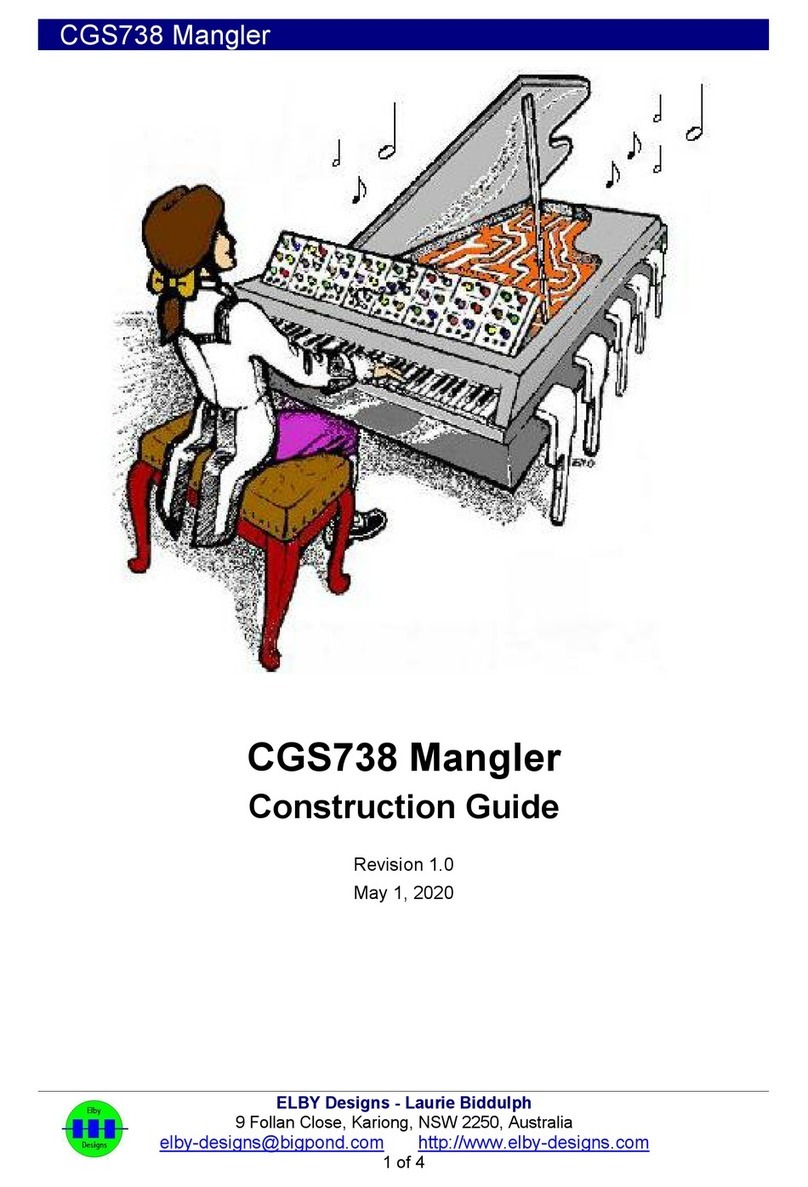
Elby Designs
Elby Designs CGS738 Instructions for use

Elby Designs
Elby Designs MonoWave(X) User manual
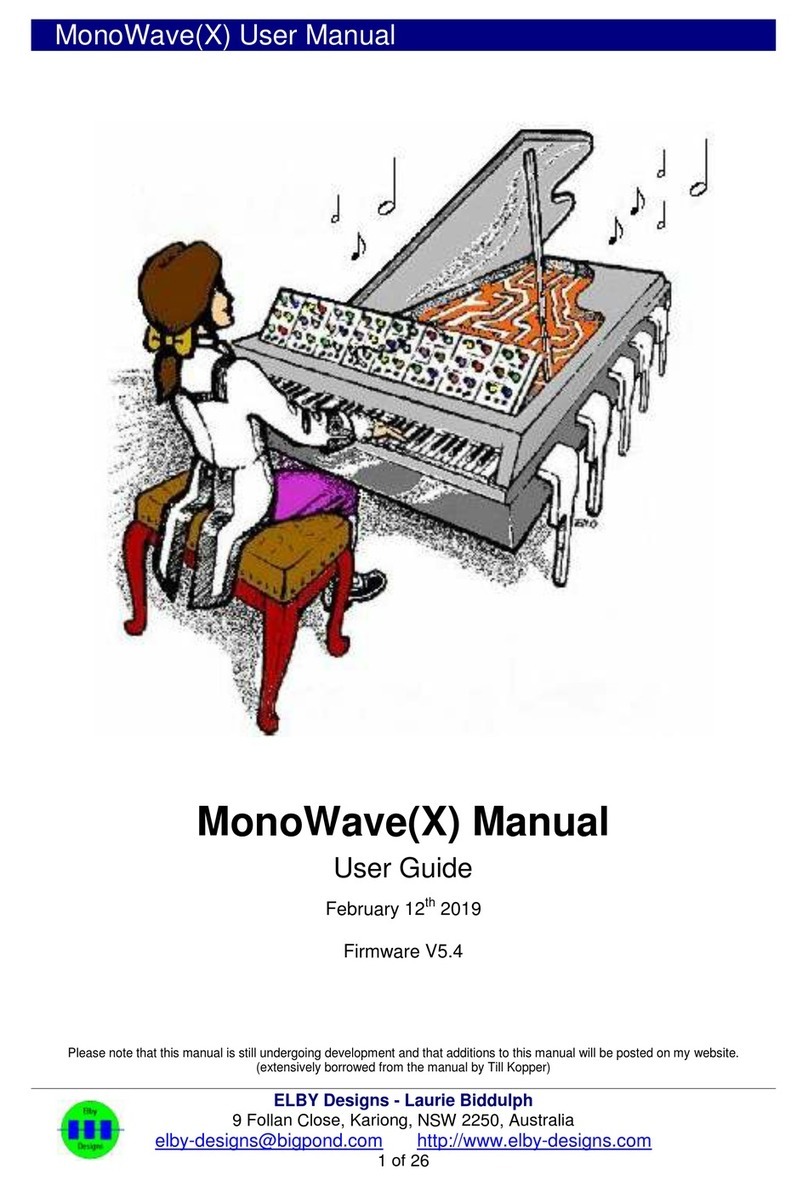
Elby Designs
Elby Designs MonoWave(X) User manual
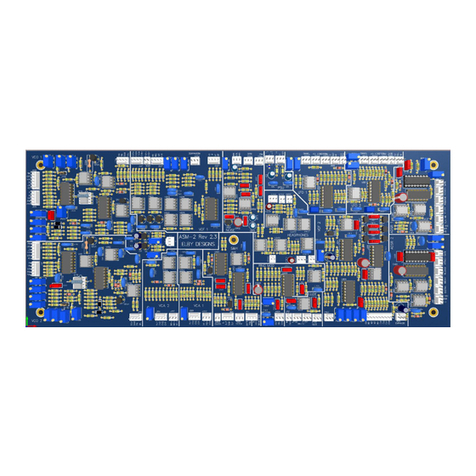
Elby Designs
Elby Designs ASM-2 Instructions for use
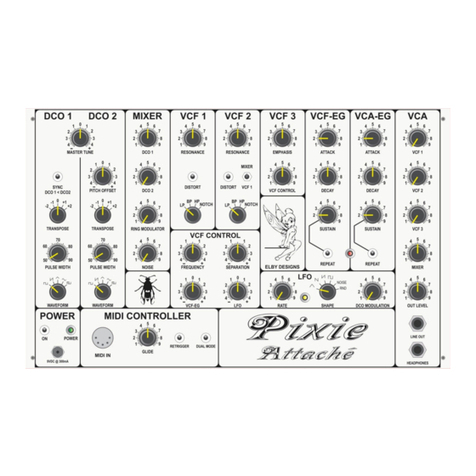
Elby Designs
Elby Designs Pixie Attache EDP WASP User manual
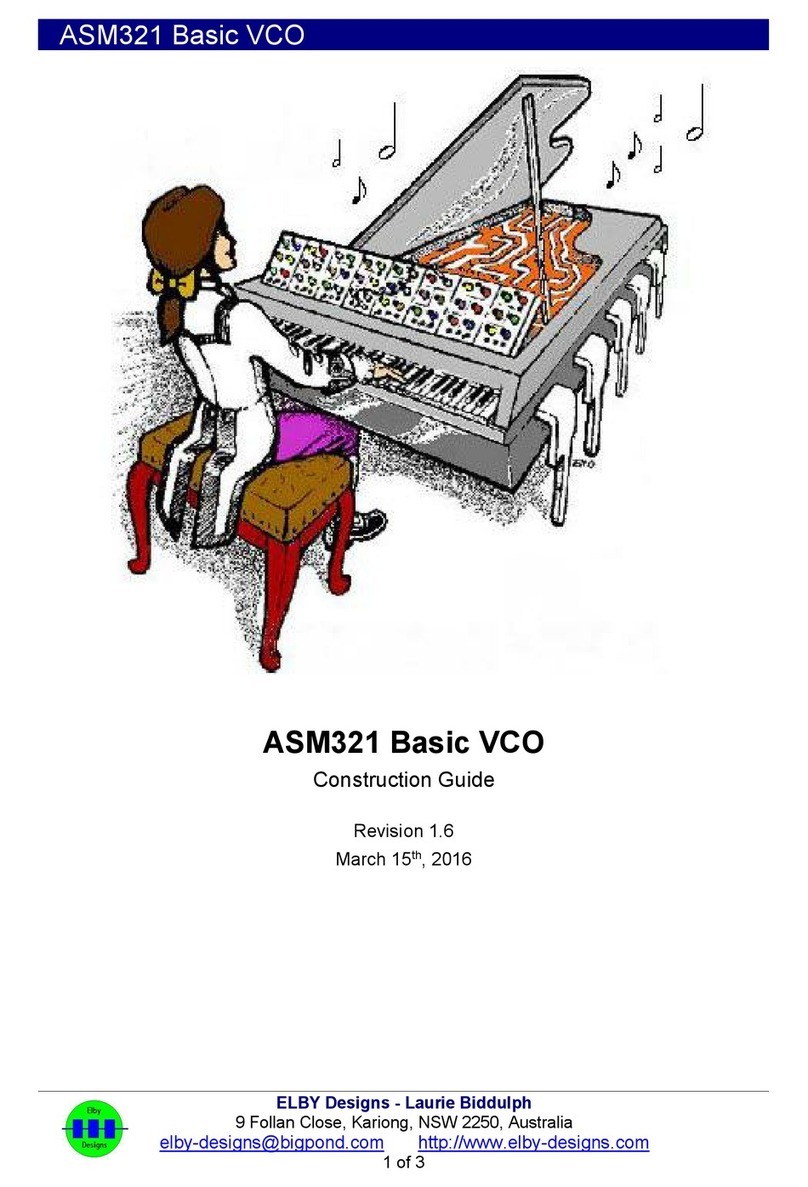
Elby Designs
Elby Designs ASM321 Instructions for use

Elby Designs
Elby Designs EURO SERGE ASM301 Instructions for use
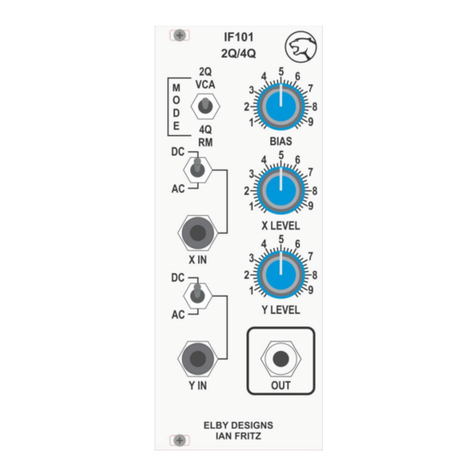
Elby Designs
Elby Designs IF101 2Q/4Q Instructions for use

Elby Designs
Elby Designs EURO STAGE ES30 Instructions for use

